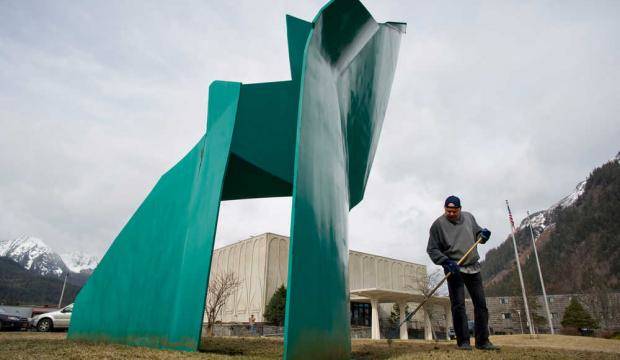After decades of debate, discussion, outrage and controversy, a triumphant Robert Murray smiled Friday night at the Alaska State Museum in Juneau.
The artist’s large, abstract statue Nimbus stood outside the building where around 40 people had gathered to hear from Murray. The statue had been taken down from its original location at the courthouse in 1984 and was installed in 1990 in front of the state museum. It has found a permanent home there: It was re-installed when the new SLAM building was built last year.
“I think we won,” Murray said. “I think the fact that Nimbus is where it is now, looking as good as it is and as fresh as the day it was made, that to me is terribly satisfying.”
The work of art appears to be there to stay, and the furor that accompanied it in the 1980s has abated to apathy or a simple lack of understanding the point of the sculpture. Many of those at Friday’s night’s talk — which involved a presentation from author Jonathan Lippincott and from Murray about the history of large abstract sculptures — were there to ask Murray more about the sculpture, from its color to its name and everywhere in between.
Many of those in attendance agreed with Renée Guerin, part of the Friends of the Alaska State Library, Archives & Museum, who said she doesn’t even consider the sculpture controversial anymore. She said the art connoisseurs in the region enjoy it, and that “there’s nothing you can do” about those who don’t.
Murray, whose works have faced resistance but never the outrage that Nimbus caused in the 1980s, is just happy that the sculpture is still standing in Juneau.
“It’s very satisfying,” Murray said, “when things come to a nice conclusion.”
One of the topics discussed Friday was the way Murray draws on Native themes and artwork, but not in an overt way where casual art observers notice. For example, the color of Nimbus, which Murray describes as “artificial green,” is taken from one of the primary colors of Tsimshian artwork. The blue-green is used frequently both in jewelry and as a backdrop in Tsimshian art, but it’s also reminiscent of the color of glacial water, Murray said Friday.
An Anishinaabe elder who served as a mentor to Murray when he grew up in Saskatoon, Saskatchewan, taught him about Native cultures and artwork. Murray has named numerous pieces of his art — that carry titles such as “Haida,” “Athabasca” and “Tlingit” — after the Alaska Native people, and also from Native words and names.
“In no Native languages that I know is there a word that translates to ‘art,’” Murray said. “It was just a part of everyday life.”
Nimbus has become that way for those in Juneau, just part of the city and part of daily existence. As one woman put it during Murray’s question-and-answer segment, Juneau has been “living with Nimbus” for decades now.
At the outskirts of the event, Goldbelt Security guard Jonathan Loney sat quietly. His desk is located by the front doors of the museum near Nimbus, but Loney doesn’t spend much time looking at the sculpture.
As he walks through the museum, doing his usual rounds, Loney is attracted much more to Alaska Native art in particular. Part of that, he said, is due to the fact that he’s one-quarter Tlingit. Another part of it is that much of the Native artwork he sees is very straightforward to him and representative of a real-life person or animal. He doesn’t want to take a side in the debate about Nimbus, preferring to view art that has a recognizable form.
“I’m just gonna leave the argument to everyone else,” Loney said, “and save myself headaches.”
• Contact reporter Alex McCarthy at alex.mccarthy@juneauempire.com or 523-2271

